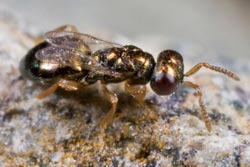Alluring Scents – Insights into the evolution of sex pheromones from a parasitic wasp

The photo shows an individual of the species Nasonia vitripennis. This species looks exactly like the closely related species Nasonia giraulti.<br><br>Photo: Dr. Oliver Niehuis, ZFMK<br>
A German-American research team from the Arizona State University (USA), the Zoological Research Museum Alexander Koenig Bonn , the University of Regensburg, and the Technical University Darmstadt used the parasitic wasp genus Nasonia to gain new insights into the process sex pheromone evolution. The result of this long lasting cooperation has now been published in Nature.
Most insects rely on their sense of smell when they seek a mating partner. They often use species specific sex pheromones to attract a suitable partner, i.e. a partner of the same species and different sex. Many sex pheromones are blends of multiple chemical components and the specific mixture/recipe of all components generates a unique and species specific blend. So far researchers assumed that individuals who used a blend that is even slightly different from their species specific blend are at a severe disadvantage compared to individuals who use the “traditional” blend in attracting mating partners.
For that reason theory predicts that the composition of sex pheromones should be extremely stable over long periods of time. Hence, scientists are puzzled by the enormous diversity of sex pheromones found today and struggle to understand how this diversity has evolved. Additionally, so far very little is known about the genetic mechanisms and molecular changes that accompany changes in sex pheromone composition.
To answer both of these questions, what is the genetic basis of sex pheromone differences and how do they evolve, researchers in Germany and USA studied two species of the parasitoid wasp genus Nasonia. Males of these species are only 2-5 mm long and attract females with a sex pheromone produced in their hindgut. The researchers discovered that the sex pheromones of all known Nasonia species are composed of two components. The only exeption is N. vitripennis which uses a novel third component.
The researchers identified the genes responsible for the production of the third pheromone component in N. vitripennis. These genes code for alcohol dehydrogenase enzymes. “These enzymes catalyze the structural reorganization of an already present sex pheromone component resulting in the generation of the third and novel sex pheromone component in N. vitripennis” explained Dr. Oliver Niehuis, director of the Molecular Laboratory of the Zoological Research Museum Alexander Koenig in Bonn. N. vitripennis males could no longer produce the novel and unique sex pheromone component once the researchers knocked down the alcohol dehydrogenase genes via dsRNAi.
Behavioral tests revealed that females of N. vitripennis do not react, if only the new component is offered. So what is the function of the novel component? “Only in combination with the other two (ancestral) components can females of N. vitripennis distinguish between conspecific males and males from sympatrically occurring closely related species” explains Prof. Dr. Joachim Ruther from the University of Regensburg. Females from the closely related and sympatric species Nasonia giraulti do not distinguish between the novel and ancestral sex pheromone with three and two components, respectively. Hence, the researchers concluded that initially females of N. vitripennis didn’t react to the third component when it first evolved. However, at some time in the evolutionary history of N. vitripennis the olfactory system of N. vitripennis adapted to the novel component and it is now an integral and distinguishing feature of the species specific sex pheromone of N. vitripennis males.
This study gives new insights into the evolution of sex pheromones and chemical communication in general. It is one of the first demonstrations how new sex pheromones can evolve by simple modifications of already existing components without losing the efficiency in the information content, i.e. males with the new scent are still attractive for mates used to the old scent.
Link to the original publication:
www: http://www.nature.com
DOI: 10.1038/nature11838
Ansprechpartner für Medienvertreter:
Dr. Oliver Niehuis
Zoologisches Forschungsmuseum Alexander Koenig
Adenauerallee 160
Tel.: 0228 9122-356
Email: o.niehuis.zfmk@uni-bonn.de
Contact in the USA;
Juergen Gadau
Arizona State University
School of Life Sciences
Office: 480-965-2349
e-mail: jgadau@asu.edu
or
Joshua Gibson
Arizona State University
School of Life Sciences
E-mail: jdgibson@asu.edu
Das Zoologische Forschungsmuseum Alexander Koenig (ZFMK) is part of the Leibniz Association, a network of 86 scientifically, legally and economically independent research institutes and scientific service facilities. Leibniz Institutes perform strategic- and thematically-oriented research and offer scientific service of national significance while striving to find scientific solutions for major social challenges.
Media Contact
All latest news from the category: Life Sciences and Chemistry
Articles and reports from the Life Sciences and chemistry area deal with applied and basic research into modern biology, chemistry and human medicine.
Valuable information can be found on a range of life sciences fields including bacteriology, biochemistry, bionics, bioinformatics, biophysics, biotechnology, genetics, geobotany, human biology, marine biology, microbiology, molecular biology, cellular biology, zoology, bioinorganic chemistry, microchemistry and environmental chemistry.
Newest articles

Properties of new materials for microchips
… can now be measured well. Reseachers of Delft University of Technology demonstrated measuring performance properties of ultrathin silicon membranes. Making ever smaller and more powerful chips requires new ultrathin…

Floating solar’s potential
… to support sustainable development by addressing climate, water, and energy goals holistically. A new study published this week in Nature Energy raises the potential for floating solar photovoltaics (FPV)…

Skyrmions move at record speeds
… a step towards the computing of the future. An international research team led by scientists from the CNRS1 has discovered that the magnetic nanobubbles2 known as skyrmions can be…





















